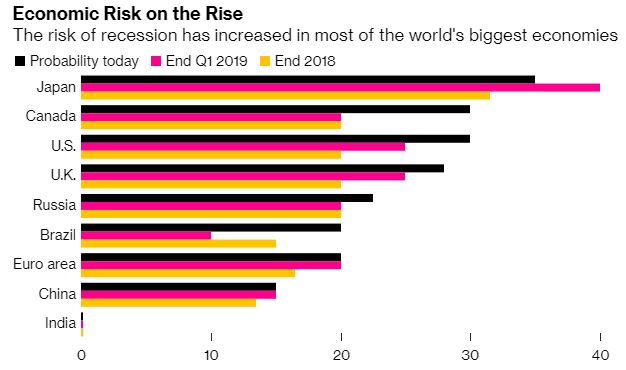
4 Easy Tips to Recession-Proof Your B2B Marketing
Editor’s note: This is a guest post by Gregg Schwartz, VP Sales & Marketing at Strategic Sales & Marketing.
Recent turbulence in the stock market, worrisome signals from the bond market, and ongoing trade disputes between the U.S. and China are all sending strong warning signs that we could be on the verge of a recession.
We’ve been enjoying a 10-year period of overall economic expansion, but as they say – all good things must come to an end. Even if things are going well for your business today, you should still brace yourself for possible economic downturns that could be on the immediate horizon.


Source: Bloomberg.com
Here are a few ideas on how to recession-proof your marketing strategy and build up resilience for possible economic downturns.
1. Diversify Your Customer Base
Are you relying too much on just a few major accounts, customers, industry categories or market segments? Even if you have found a profitable niche during the boom years, that doesn’t mean you should assume that these same customers are going to be around forever in case of a recession.
Think strategically about your portfolio of customers. For example, are some of your customers in growth industries that didn’t exist 5 years ago? What happens if your customers’ industry suffers a downturn or a shortage of financing – are you possibly vulnerable to a bubble that is about to pop? Are your biggest markets vulnerable to any particular changes in ease of access to funding, shifts in economic policy, or downgrades in international trade conditions?
Since many businesses have been hit hard by the recent trade disputes and tariffs between the U.S. and China – you might want to diversify your business away from one or two particular countries or markets.
Ultimately, diversifying your base of customers is a smart approach, because it will help you build a broader safety net for your business. Instead of relying on just a few customers, or just a few types of customers, you can expand your marketing presence into a wider variety of situations – so even if a recession hits, you’ll be more likely to be able to keep making sales.
2. Cut Costs Now
Review your overall spending on marketing. Are there any marketing strategies that are underperforming, any marketing channels or platforms that haven’t panned out? Reduce expenses in those areas, and bulk up your cash reserves or put that money into better-performing strategies instead. When the economy is going strong and sales inquiries are coming in, it’s easy to assume that everything is fine and stop casting such a sharp eye onto your marketing budget. But good times are an ideal occasion to trim the fat out of your marketing budget.
Saving some money now and re-directing your marketing investments away from some poorly-performing activities and toward some higher-potential ones, is an ideal way to give your company an additional financial cushion to help ride out the possible downturn.
3. Expand into New Markets
Part of diversifying your base of business is making sure you have different streams of revenue from different types of markets, products, and industries. If a recession does occur, not all industries will be equally affected as some industries tend to be more stable than others. For example, if you mainly sell to fast-growing tech startups, you might want to consider selling to some more established companies or industry sectors or start selling to government agencies.
If your primary customers are concentrated in a particular B2B industry that has been seeing intensifying competition, you might want to start marketing to a totally different industry that is perhaps not as fashionable or frothy, but that is a good fit for your solution.
Think carefully and critically about what is your core value proposition and how could the solutions that you sell be relevant to the needs of different types of customers; what about your solution is transferable to different industries and different types of organizations? It might take time and energy to learn how to market and sell to different customers in a different industry setting, but it’s worth it if you can create a broader base of business.
4. Take Calculated Risks
When times are good, it’s easy to get complacent. When money keeps coming in, it’s easy to take your foot off the gas and coast for a while. But remember, the best time to make bold moves is when you’re already in demand. Keep pushing the envelope and trying new things.
Do you want to experiment with a new product launch, try some new marketing channels, invest in professional development, attend a big-name industry conference, or otherwise put yourself out there to take your business to the next level? Now is the time. Especially if the phone is already ringing with new customers, if you’ve got money in the bank, if you’re feeling confident, you might not get a better chance than right now to try some exciting new marketing strategies.
In conclusion, don’t get blind-sided by the next recession. As business leaders, there are many things we cannot control, but we can control how well we adjust and respond to the new challenges that are emerging around us.
The next recession could happen at any time, but that doesn’t mean you should panic. Instead, use this moment as an opportunity to take a step back, and enact careful planning and prudent strategies to make your company’s B2B marketing more resilient, responsive, and hopefully recession-proof! 

Gregg Schwartz is the Vice President of Sales and Marketing at Strategic Sales & Marketing, a lead-generation firm based in Connecticut, USA.




